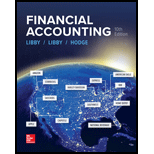
Describe the roles and responsibilities of management and independent auditors in the financial reporting process.
Explanation of Solution
Financial reporting: Financial reporting is the procedure to communicate the information obtained from the financial statements prepared. It is necessary to disclose the data to various stakeholders as various decisions needs to be taken by the stakeholders.
Generally Accepted Accounting Principles: They are commonly known as GAAP. It is a collection of generally practiced and followed rules and standards of accounting. GAAP provides global guidelines for preparation and disclosure of financial statements of public companies. It is created and developed by International Accounting Standards Board (IASB).
Public Company Accounting Oversight Board (PCAOB): A non-profit organization established by Sarbanes-Oxley Act of 2002 that ensures the application of auditing standards by the independent auditors to minimize the audit risk.
The roles and responsibilities of management and independent auditors in the financial reporting process can be explained as follows:
- The management includes the Chief Executive Officer (CEO) and the Chief Financial Officer (CFO) who are responsible for the precision and correctness of the financial statements, and to conform that the statements prepared, are in accordance with the Generally Accepted Accounting Principles (GAAP).
- Independent auditors are entrusted with the responsibility to conduct thorough examination of financial statements ensuring the fairness of accounting information provided, through adherence with the mandatory accounting standards. The auditors are also required to follow the auditing standards prescribed by the Public Company Accounting Oversight Board (PCAOB) that minimizes the audit risk.
Want to see more full solutions like this?
Chapter 5 Solutions
Financial Accounting
- What is the sales margin for the division?arrow_forwardA new machine with a purchase price of $90,000, transportation costs of $8,000, installation costs of $6,000, and special handling fees of $2,000, would have a cost basis of___. a. $106,000 b. $110,000 c. $108,000 d. $102,000arrow_forwardSamuel Enterprises had an $185,000 beginning balance in Accounts Receivable. During the year, credit sales were $680,000 and customers' accounts collected were $590,000. What was the net amount of receivables included in the current assets at the end of the year, before any provision was made for doubtful accounts?arrow_forward
- Provide answerarrow_forwardThe ceiling test in defined benefit plans____. (A). Determines maximum benefits (B). Sets minimum contribution levels (C). Limits the surplus that can be recognized (D). Establishes funding requirements answerarrow_forwardThe ceiling test in defined benefit plans____. (A). Determines maximum benefits (B). Sets minimum contribution levels (C). Limits the surplus that can be recognized (D). Establishes funding requirements provide answerarrow_forward

 AccountingAccountingISBN:9781337272094Author:WARREN, Carl S., Reeve, James M., Duchac, Jonathan E.Publisher:Cengage Learning,
AccountingAccountingISBN:9781337272094Author:WARREN, Carl S., Reeve, James M., Duchac, Jonathan E.Publisher:Cengage Learning, Accounting Information SystemsAccountingISBN:9781337619202Author:Hall, James A.Publisher:Cengage Learning,
Accounting Information SystemsAccountingISBN:9781337619202Author:Hall, James A.Publisher:Cengage Learning, Horngren's Cost Accounting: A Managerial Emphasis...AccountingISBN:9780134475585Author:Srikant M. Datar, Madhav V. RajanPublisher:PEARSON
Horngren's Cost Accounting: A Managerial Emphasis...AccountingISBN:9780134475585Author:Srikant M. Datar, Madhav V. RajanPublisher:PEARSON Intermediate AccountingAccountingISBN:9781259722660Author:J. David Spiceland, Mark W. Nelson, Wayne M ThomasPublisher:McGraw-Hill Education
Intermediate AccountingAccountingISBN:9781259722660Author:J. David Spiceland, Mark W. Nelson, Wayne M ThomasPublisher:McGraw-Hill Education Financial and Managerial AccountingAccountingISBN:9781259726705Author:John J Wild, Ken W. Shaw, Barbara Chiappetta Fundamental Accounting PrinciplesPublisher:McGraw-Hill Education
Financial and Managerial AccountingAccountingISBN:9781259726705Author:John J Wild, Ken W. Shaw, Barbara Chiappetta Fundamental Accounting PrinciplesPublisher:McGraw-Hill Education





